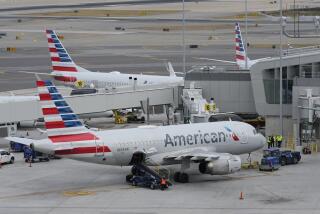Fees for airline extras have made the trip to Europe
- Share via
The era of passenger fees — charges for checked bags, seat upgrades and onboard food — began to take hold in the U.S. when airlines tried to offset their losses from surging fuel prices in 2008.
Now, with Europe in the grip of the longest recession in decades, the trend of charging passengers for such extras is taking off with the full-service airlines across the pond.
Taken together, 53 of the world’s major airlines collected $27.1 billion in passenger fees and other charges in 2012, up 19% compared with $22.6 billion raised in 2011 by 50 airlines, according to a new report by IdeaWorks, a Shorewood, Wis., airline consulting firm.
A bigger share of those fees are coming from major European airlines, which have struggled with Europe’s economic slump and stiff competition from low-cost airlines that have reaped hefty revenues from passenger fees for years.
The Dutch airline KLM became the first full-service European carrier in April to charge bag fees. Members of the airline’s loyalty program are exempted from the fees.
Air France and KLM, which are owned by the same French holding company, jumped onto the list of the world’s top 10 generators of passenger fees for the first time this year, ranking seventh by collecting $1.2 billion, according to the IdeaWorks report. The two airlines did not publicly release ancillary fee information last year.
In addition, German airline Lufthansa turned over most of its short-haul flights that don’t serve major hubs to its low-cost subsidiary, Germanwings, which charges for checked bags, seat assignments and food and drinks.
British Airways now offers airfares with or without baggage fees included.
“I think this is going to open the floodgates in the next few years for this to be a long-haul phenomenon,” said Jay Sorensen, president of IdeaWorks
•
When flight attendants order travelers to shut off their electronic devices during takeoffs and landings, they disrupt a lot of valuable technological activity.
Well, maybe the activity is not so valuable, but there is a lot of it.
More than 105 million hours of activity on electronic devices are expected to be disrupted in 2013 by the Federal Aviation Administration’s ban on using such devices during takeoffs and landings, according to a study by DePaul University’s Chaddick Institute for Metropolitan Development.
The number of lost hours gaming or reading jumped from 51.7 million in 2010, according to the study, which is based on observations of nearly 1,700 passengers on 23 flights.
The study estimates that the use of electronic devices on planes is surging, with more than 35% of travelers using gadgets such as electronic tablets and smartphones at some point in a flight, up from 28% in 2012 and 17.6% in 2010.
The study concludes that the FAA ban on electronic devices during takeoffs and landings comes at a “high cost to the traveling public in regards to technology use.”
It goes on to suggest that the FAA “follow an aggressive timetable for lifting the ban and allowing passengers more time to ‘power up.’ ”
The FAA has already assembled a panel to consider lifting the ban on using e-readers, tablets and other devices on planes. Cellphone calls will be off the table. A report from the committee is expected to be released at the end of July.
With the ban still in place, AirTran Airways last week reported that its crews removed 100 high school students and eight chaperons from a flight from New York to Atlanta.
A spokeswoman for the airline, a subsidiary of Southwest Airlines, said the group was bumped because of “behavior and inability to comply with our flight attendants requests.” One request they refused, the airline said, was to turn off their cellphones.
More to Read
Inside the business of entertainment
The Wide Shot brings you news, analysis and insights on everything from streaming wars to production — and what it all means for the future.
You may occasionally receive promotional content from the Los Angeles Times.










